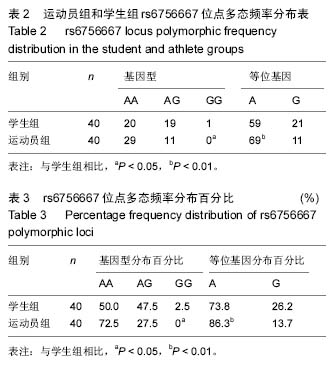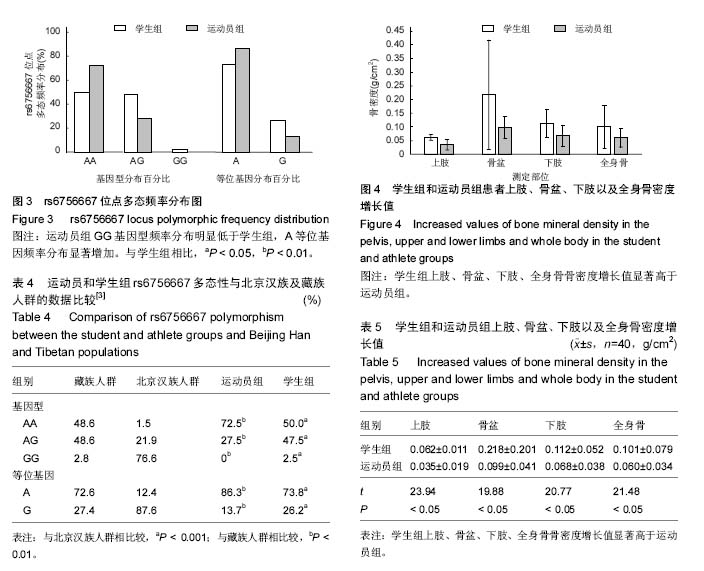| [1] Beall CM,Cavalleri GL,Deng L,et al. Natural selection on EPAS1 (HIF2alpha) associated with low hemoglobin concentration in Tibetan highlanders. Proc Natl Acad Sci USA.2010;107(25): 11459-11464.[2] Yi X,Liang Y,Huerta-Sanchez E,et al. Sequencing of 50 human exomes reveals adaptation to high altitude. Science.2010;329(5987): 75-78.[3] Simonson TS,Yang Y,Huff CD,et al. Genetic evidence for high altitude adaptation in Tibet. Science. 2010; 329(5987): 72-75.[4] 陈郁,蒋春华.EPAS1基因rs6756667及rs7583392多态性与汉族男性高原红细胞增多症的相关性研究[J].解放军医学杂志,2012,37(12): 1120-1124.[5] Beall CM,Cavalleri GL,Deng L,et al. Natural selection on EPAS1 (HIF2alpha) associated with low hemoglobin concentration in Tibetan highlanders. Proc Natl Acad Sci USA.2010;107(25): 11459-11464.[6] Henderson J,Withford-Cave JM,Duff DL,et al.The EPAS1 gene influences the aerobic-anaerobic contribution in elite endurance athletes.HumGenet. 2005;118(3-4):416-423.[7] 金溪,胡扬,罗冬梅,等.从HIF-2a基因筛选HiHiLo实施过程中预测血象指标变化的分子标记[J].体育学刊, 2010,17(6):6-7.[8] 安彦.久居或世居高原运动员的高原训练[J].吉林体育学院学报,2008,24 (1):86-87. [9] 陈秋红,格日力.世居及移居高原青少年最大有氧能力的特征[J].中国应用生理学杂志,1994,10(04):289-292. [10] 祁继良.赛前高原训练对世居高原运动员身体机能的影响研究[J].安徽体育科技,2009,30(5):35-38.[11] 赵晋.高原、亚高原训练对世居亚高原运动员运动能力的影响及其机制研究[D].北京体育大学,2006.[12] Beall CM. Andean, Tibetan, and EthioPian Patterns of adaPtation to high-altitude hypoxia. Integr Comp Biol. 2006;46(1):18-24. [13] Garruto RM, Chin CT, Weitz CA,et al. Hematological differences duringgrowth among Tibetans and Han Chinese born and raised at high altitude in Qinghai,China. Am J Phys AnthroPol.2003;122(2):171-183.[14] Wu TY. Chronic mountain sickness on the Qinghai- Tibetan Plateau.Chin Med J(Engl).2005;118(2): 161-168.[15] Anderson ER,Xue X,Shah YM.Intestinal hypoxia inducible factor-2alpha (HIF-2alpha) is critical for efficient erythropoiesis.J Biol Chem.2011;286(22): 19533-19540.[16] 洪长清,谢敏豪,严翊.补充果糖-1,6-二磷酸钙对男子举重运动员大负荷力量训练期间红细胞指标及免疫激活状态的影响[J].中国运动医学杂志,2010,29(5):530-532.[17] 顾汉文,李敏,雷明智,等.陕西省体育高考生业余训练运动损伤的调查分析[J].陕西教育(高教),2010(3):394-396.[18] 孙建华.我国优秀女子排球运动员赛前有氧能力特征综合检测分析[J].中国体育科技,2012,48(1):62-67.[19] Eghbali-Fatourechi G,Khosla S,Sanyal A,et al. Role of RANK ligand in mediating increased bone resorption in early postmenopausal women. Clin Invest.2003;111 (8):1221-1230[20] 孟迅吾,李梅.甲状旁腺素防治原发性骨质疏松症的研究进展[J]. 国外医学:内分泌学分册,2003,23(2):106-108.[21] 张娜,曹艳,史亦丽.骨质疏松症治疗药物应用分析[J].中国医院用药评价与分析,2006,6(5):286-289.[22] Siris ES,Miller PD,Barrettconnor E,et al.Identification and fracture outcomes of undiagnosed low bone mineral density in postmenopausal women: Results from the national osteoporosis risk assessment. JAMA.2001;286( 22) : 2851-2822.[23] 米霞,彭述文,谢江其,等.CT定量测定老年性骨密度在预防老年性骨质疏松性骨折的临床应用[J]. 国际医药卫生导报,2005,11(18):89.[24] Prelack K, Dwyer J, Ziegler P.Bone mineral density in elite adolescent female figure skaters. J Int Soc Sports Nutr. 2012;9(1):57-62.[25] Niu K, Ahola R, Guo H, et al.Effect of office-based brief high-impact exercise on bone mineraldensity in healthy premenopausal women: the Sendai Bone HealthConcept Study.Bone Miner Metab.2010;28(5):568-577.[26] 郑庆云,李世昌.BMP-2在不同运动方式中的表达及对骨代谢的影响[J].山东体育学院学报,2011,27(8):47-51.[27] 张庆来,刘伟.2014年山东省大学生体质监测结果分析与评价[J].山东体育科技,2005,(3):48-51.[28] 王秀华.浅析少年儿童身体素质下降的原因及提高的对策[J].中国科教创新导刊,2011,(12):174.[29] 殷怀明.维生素D受体基因多态性对儿童营养性佝偻病骨代谢的影响[J].浙江预防医学,2011,23(6):18-19 +23.[30] 郭敏,李宇宁,凌继祖,等. 维生素D受体基因BsmI及FokI 位点单核苷酸多态性与维生素D缺乏性佝偻病的相关性[J]. 临床儿科杂志,2012,30(1):1047-1050.[31] 韩昕,詹志伟,张红红,等. 北京部分汉族男性维生素D受体基因FokI多态性与骨密度的关系[J]. 中国组织工程研究与临床康复,2009,13(24):4763-4766.[32] 葛继荣,陈可,谢丽华,等.维生素D受体基因ApaI多态性与绝经后妇女骨密度的关系[J]. 中国骨质疏松杂志, 2010, 16(10):719-722.[33] Sinha A,Avery P,Turner S,et al. Vitamin D status in paediatric patients with cancer. Pediatr Blood Cancer. 2011;57(4) :594-598.[34] 郑敏,罗建明.广西地区儿童维生素D受体基因 FokI 位点多态性分布研究[J].临床儿科杂志,2010,28(11): 1061-1063.[35] 张维华,李宇宁,金玉,等.维生素D受体基因FokI、TaqI多态性与女性婴幼儿佝偻病的相关性[J].实用儿科临床杂志, 2009,4(7) : 505-507.[36] 邢丹,马信龙,马剑雄,等. 维生素D受体基因 BsmI、ApaI、TaqI、FokI和Cdx-2位点多态性与骨质疏松性椎体骨折相关性的Meta分析[J]. 中华骨质疏松和骨矿盐疾病杂志, 2013,6(2):165-173.[37] 席卫平,杨建平,李连青,等.维生素D受体基因ApaI位点多态性与维生素D缺乏性佝偻病的研究[J].中华儿科杂志, 2005,43(7):514-516.[38] Gao L,Tao Y,Zhang L,et al. Vitamin D receptor genetic polymorphisms and tuberculosis: updated systematic review and meta-analysis. Int J Tuberc Lung Dis. 2010; 14(1):15-23.[39] 徐金瑞,纳小菲,杨易.宁夏汉族人群 VDR基因4个SNPs 位点基因多态性与2型糖尿病的关联性分析[J].吉林大学学报:医学版,2012,5(9):985-989.[40] 梁利波,王佑娟,张玫,等. 亚临床甲状腺功能减退症与骨密度及骨代谢指标的相关性研究[J].四川大学学报医学版,2014,45(1): 66-69. |
.jpg)




.jpg)